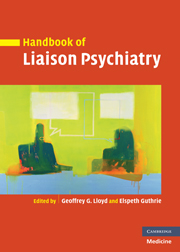Book contents
- Frontmatter
- Contents
- List of contributors
- Preface
- Part I Basic skills
- Part II Common psychiatric problems across the general hospital
- Part III Working with specific units
- 14 Neurological disorders
- 15 Cardiorespiratory disorders
- 16 Gastrointestinal disorders
- 17 Liver disorders
- 18 Endocrine disorders
- 19 Diabetes
- 20 HIV and AIDS
- 21 Renal disease
- 22 Musculo-skeletal disorders
- 23 Oncology
- 24 Head and neck cancer
- 25 Palliative care
- 26 Cosmetic procedures
- 27 Perinatal and gynaecological disorders
- 28 The intensive care unit
- 29 The burns unit
- 30 Psychocutaneous disorders
- 31 Genitourinary disorders
- 32 The emergency department
- Part IV Treatment
- Part V Different treatment settings
- Index
- References
22 - Musculo-skeletal disorders
from Part III - Working with specific units
Published online by Cambridge University Press: 10 December 2009
- Frontmatter
- Contents
- List of contributors
- Preface
- Part I Basic skills
- Part II Common psychiatric problems across the general hospital
- Part III Working with specific units
- 14 Neurological disorders
- 15 Cardiorespiratory disorders
- 16 Gastrointestinal disorders
- 17 Liver disorders
- 18 Endocrine disorders
- 19 Diabetes
- 20 HIV and AIDS
- 21 Renal disease
- 22 Musculo-skeletal disorders
- 23 Oncology
- 24 Head and neck cancer
- 25 Palliative care
- 26 Cosmetic procedures
- 27 Perinatal and gynaecological disorders
- 28 The intensive care unit
- 29 The burns unit
- 30 Psychocutaneous disorders
- 31 Genitourinary disorders
- 32 The emergency department
- Part IV Treatment
- Part V Different treatment settings
- Index
- References
Summary
Introduction
The term musculo-skeletal disorders describes a broad range of problems, with varying aetiologies and different natural histories, that are seen and treated in diverse treatment settings. These disorders have in common symptoms (with or without signs) in the muscles, skeleton or connective tissues, with associated functional disability.
It is beyond the scope of this chapter to describe all of the individual musculo-skeletal disorders along with their accompanying psychological/psychiatric features. Instead we have selected the four conditions that best represent the conditions within this group: rheumatoid arthritis, fibromyalgia, osteoarthritis and back pain. By discussing the features of these disorders we have covered the most common, and the most widely studied of the musculo-skeletal disorders.
Rheumatoid arthritis
Rheumatoid arthritis (RA) is a chronic inflammatory disorder of unknown aetiology affecting approximately 0.8% of the population, with women being affected three times more often than men. The brunt of this disorder falls on articular and periarticular tissues, resulting in a peripheral symmetrical inflammatory arthropathy. Destruction of joint cartilage and bony erosions can occur, which eventually lead to destruction of the joint. Some degree of extra-articular involvement is found in most sufferers. These extra-articular manifestations vary widely between subjects but may include systemic symptoms (anorexia, weight loss, myalgia), more localized abnormalities such as rheumatoid nodules, or involvement of the cardiovascular system (vasculitis, pericarditis), respiratory system (pleural effusions, pulmonary fibrosis), or central nervous system (spinal cord compression, peripheral neuropathy).
Onset, most commonly in the third and fourth decades, is insidious in the majority of cases.
Keywords
- Type
- Chapter
- Information
- Handbook of Liaison Psychiatry , pp. 527 - 546Publisher: Cambridge University PressPrint publication year: 2007

